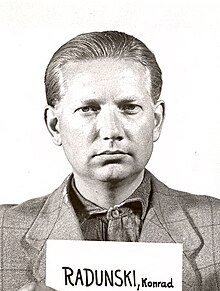Konrad Radunski
Konrad Radunski (born June 1, 1907 in Heppens ; † June 18, 1985 ) was a German medic, SS leader and functionary .
Live and act
Radunski came to China with his parents in 1912 . In 1913 he began his school career in Tsingtau . From 1913 to 1915 he attended a school in Tientsin , then until 1919 a school in Shanghai . When the Germans were repatriated in China after the end of the First World War , the family settled in Wilhelmshaven , where Radunski was taught in a high school, which he graduated from in 1926 .
From 1926 to 1932 Radunski studied medicine at the Universities of Göttingen , Rostock , Marburg and Kiel . He then worked as a laboratory assistant at various clinics in Kiel until 1935. 1935 Radunski that since 1932 the NSDAP ( member number 1113971) belonged, because of his background as abroad German in the Unit for German abroad (VDA) to Berlin fetched. From there he was sent to the SD main office for administrative training , where he worked for the Volksdeutsche Mittelstelle (Vomi), which dealt with settlement issues , in Departments I and II (personnel and organization) of the SD main office. In the SS he was listed as a member on November 1, 1935 and assigned to the security service of the Reichsführer SS (SD). His last rank in the SS was that of SS-Obersturmbannführer .
In the autumn of 1938 Radunski was seconded as a liaison leader to the foreign organization of the NSDAP , a position he held until the outbreak of World War II .
Shortly after the outbreak of World War II, Radunski was forced to join the resettlement command of the Volksdeutsche Mittelstelle, which made him automatically a member of the Waffen SS . At the resettlement command, he was a staff leader of Dr. Schmidt, the assignee of the Vomi for the resettlement of ethnic Germans in Stanislau in Galicia on, one of the five individual commands in agreement with the Soviets in the Soviet-occupied territory of Poland located in Germany should be converted into the German area populations. In 1940 Radunski took part in negotiations for similar resettlement actions in Latvia and Estonia , which a German delegation led in Moscow and Riga , and which he then managed himself until spring 1941. At this time he played an important role, particularly in the integration of the resettled “ethnic Germans” into the German war economy.
In March 1941 Radunski switched to the SS-Ersatz-Bataillon-Nord in Goslar . At the beginning of the war against the Soviet Union he was transferred to the Leibstandarte SS Adolf Hitler , with whom he fought on the Eastern Front as leader of a machine gun company until November 1941. At the end of 1941 Radunski was then ordered back to the Volksdeutsche Mittelstelle. On April 20, 1942, he took over the position of personnel manager at Vomi. In 1943 he was also appointed head of personnel at the VDA. He retained these two departments until the end of the war in 1945.
At the end of the war Radunski fell into English captivity . In the following years he participated as a witness in the Nuremberg trials . After his release, he settled in Neuendorf / Steinburg , where he was briefly mayor. He later worked at the Federal Youth Social Welfare Office in Frankfurt and Stuttgart . He then worked for AEG-Telefunken in the space and satellite technology department in Backnang . With his four children and his wife Luise, geb. Kirch, he then lived in Oppenweiler , Backnang district (later Rems-Murr district ).
literature
- Valdis O. Lumans: Himmler's Auxiliaries. The Volksdeutsche Mittelstelle and the German national minorities of Europe, 1933–1945. Univ. of North Carolina Press, Chapel Hill / London 1993, ISBN 0-8078-2066-0 .
Individual evidence
| personal data | |
|---|---|
| SURNAME | Radunski, Konrad |
| BRIEF DESCRIPTION | German SS leader and functionary |
| DATE OF BIRTH | June 1, 1907 |
| PLACE OF BIRTH | Heppens |
| DATE OF DEATH | June 18, 1985 |
| Place of death | Oppenweiler |
